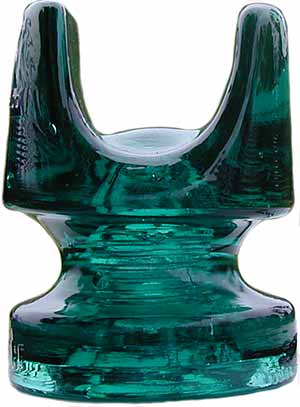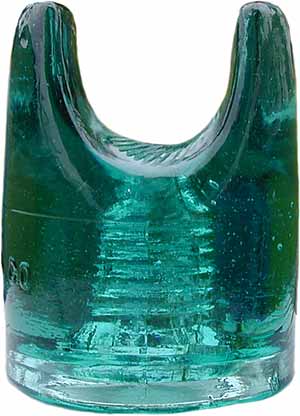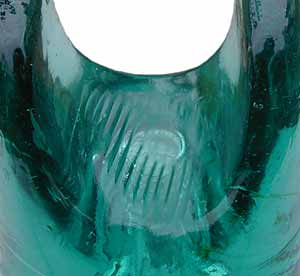[ Home | What's New | Articles ]
The CD 267.5 "straight-sides" were used exclusively on the former MBTA Orange Line which extended from downtown Boston in a westerly direction for several miles. A portion (about three miles from its west terminus) was elevated above city streets and the line was built in 1899. I have always believed that the CD 267.5 was made on special order for this line by the New England Glass Manufacturing Company (which existed only during 1899 in Boston).
 CD 267 |
 CD 267.5 |
The heavy DC cables which operated this line were laid beneath the catwalk which was between the east and westbound tracks. The cables were very impressive in size and were simply laid within the insulators' saddle grooves without the need of a tie-wire. The spacing between each "crossarm" (which was a 3 to 4 foot long heavy wooden timber with short stubby pins inserted in them) was roughly 12 to 15 feet. Originally the copper stranded cable was cloth insulated, however with time and exposure to the elements the insulation eventually wore down to the bare copper strand. These twisted strands can be sometimes seen within the saddle grooves of the CD 267.5 and CD 267 insulators (also used in quantity on this line). Much of this effect is due to the many years of vibration from the passing trains and also the weight of the conductor as well. There were 4 insulators per "crossarm".
 |
|
Wear in the saddle groove from the rubbing of the copper cable |
The "Orange" Line was decommissioned in 1988. There were some insulators retrieved (by me and two other collectors) from the demolition contractor. However, the majority of the CD 267.5 and CD 267 insulators that came from the Orange Line were "liberated" in 1975 by brazen, so-called collectors during the middle of the night while the track was idle.
In addition to copper strand marks in the aforementioned insulators' saddles, one can sometimes see what look like ground bases. Actually, this is the result of the insulator sitting right upon its "crossarm" in such a fashion that you can sometimes see the wood grain marks embedded right into the base rim! You talk about character!
The elevated section was only scattered with glass insulators by the time of its demise. Approximately 60% or more of the insulators in place at that time were large white porcelain cleats. It appeared that some sections were originally built with these insulators while others were insulated with glass. Through the years, vibration, extreme temperature changes and the heavy weight of the cables caused some of the glass insulators to break. Porcelain cleats were used for replacements.
The CD 267 insulators employed on this line were unembossed and embossed No. 4 Cables (in light and dark aqua) and N.E.G.M. Co.'s in a wide variety of color from light green to near-olive. I believe the vast majority of CD 267's in the hobby today were used on the Orange Line. All are neat examples of early transportation history in Boston!
You may also want to read this article about the New England Glass Manufacturing Company.
I hope this information will be of interest to you.
Good Collecting,
Joe Maurath, Jr.
![]() Return to the Research Articles
page
Return to the Research Articles
page
If you have questions or comments, please use this Feedback Form.
Last updated Tuesday, June 8, 2004